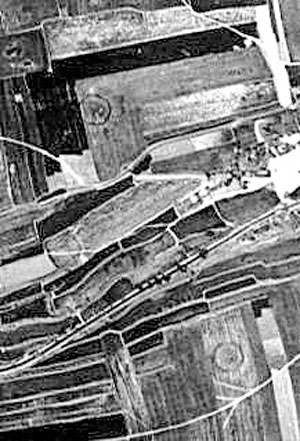

Posted on 12/21/2006 2:55:55 PM PST by blam
Mysterious rings found at tomb of Chinese only empress
Chinese archaeologists have found a group of huge rings at the site of the 1,300-year-old tomb of Wu Zetian, China's only empress, but they are unable to explain their existence.
At least 10 rings appeared on aerial photographs taken by experts from the Xi'an Preservation and Restoration Center of Cultural Relics and Qianling Museum in a survey of Qianling.
Most of the rings were 30 to 40 meters in diameter and were in a zone four kilometers long from east to west and two kilometers from south to north, said Qin Jianming, a researcher with the center.
The most eye-catching was the largest ring, with the diameter of 110 meters sited in fields, he said.
Qin said the foundation of the largest ring was three meters thick, and the color was distinctly darker than the fields. Three quarters of the ring were clearly visible, despite being broken by a footpath.
"At first we believed the rings were atmospheric phenomena caused by lights, but after analysis and comparison with previous aerial photos, we are sure they are historic remains," he said.
Located 80 kilometers northwest of the ancient city of Xi'an, capital of northwest China's Shaanxi Province, Qianling is the joint tomb of Wu Zetian, who ruled for 50 years, and her husband, Emperor Li Zhi of the Tang Dynasty (618-907).
It is the only tomb in China which contains the bodies of two rulers. Wu Zetian was buried in the tomb 22 years after her husband.
Qianling is the best preserved ancient tomb in China and has not been looted.
The researchers conducted a ground search for the rings three to five kilometers from Lianshan mountain range, which was the territory of Qianling, and they were difficult to see from the ground.
"The layout of the rings seems irregular and some are no longer intact. We are assuming there were more rings in the past, but they have eroded due to geographical conditions and human activities," said Qin.
Despite searches of historical records, the researchers still have no idea of the purpose of the rings or their relation with the tombs.
"Based on our experience, we assume they were tunnels built in ancient times," said Qin.
However, the center of the largest ring was an excavated tomb belonging to a ruler of the Yan State in the Tang Dynasty, which was a subsidiary tomb of Qianling, but it was uncertain if the ring was part of the tomb, said Fan Yingfeng, head of the Qianling Museum.
"Human activities in that area began in New Stone Age. Emperor Qin Shihuang built a palace there and rebellious forces in late Tang Dynasty occupied the area as well," he said.
Experts said the discovery indicated there might be more historic relics yet to be discovered in the Qianling area.
Source: Xinhua
Please FREEPMAIL me if you want on or off the
"Gods, Graves, Glyphs" PING list or GGG weekly digest
-- Archaeology/Anthropology/Ancient Cultures/Artifacts/Antiquities, etc.
Gods, Graves, Glyphs (alpha order)
Olympics logos?
Definitely a herd of Chapa'ai.
There is a guy who admits and has demostrated how he and a couple of friends make the crop circles.



Carolyn
You were calling me?

In brightest day
in blackest night...
no evil shall escape my sight
for those who worship evils might...
Beware my Power, GREEN LANTERNS LIGHT!!!
Crop circles?

http://www.photogrammetry.ethz.ch/research/3Dmodels/nasca.html
this site has several 3D images, the one above is my favourite, it looks as if the lines existed before the mountain was 'washed away'
http://web.archive.org/web/20030529152233/http://www.cat.cc.md.us/~adeil450/contrivers.html
Doug and Dave.
I wonder if the Nazca lines weren't related to high-altitude agriculture -- analogous to the efforts of the Nabataeans (city of Petra) to capture runoff?
http://www.photogrammetry.ethz.ch/research/3Dmodels/images/whaleFlat.jpg
enlarge this 3D view.find the Whale. Look closely...if it rained, where would the water go? There are no cysterns, no dams and no terraces.
Keeping it from running off, so that it soaks in, perhaps?
I think this was the already quite sophisticated agricultural system employed throughout the area...
http://www.oas.org/dsd/publications/Unit/oea59e/ch27.htm
This reminds me of the Ant:
http://www.oas.org/dsd/publications/Unit/oea59e/p179.GIF
Ant?
As in the nest of ants???
Oh, I guess it's a spider:
http://www.webtre.it/Principale/QuadriCentraleLaterali/Misteri/AntAstronauti/Nazca.jpg
Disclaimer: Opinions posted on Free Republic are those of the individual posters and do not necessarily represent the opinion of Free Republic or its management. All materials posted herein are protected by copyright law and the exemption for fair use of copyrighted works.